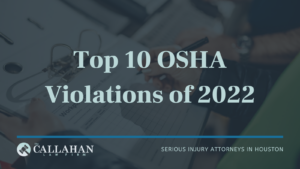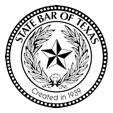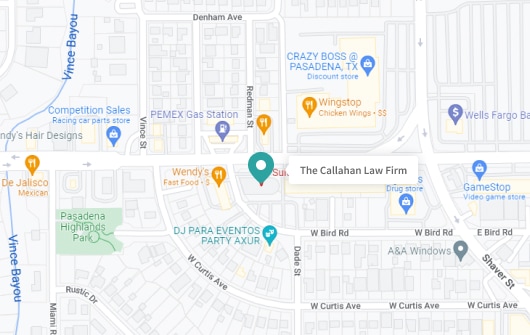Top 10 OSHA Violations of 2022

OSHA just released a list of the top ten violations for 2022. Each year, they make a list to determine the most commonly found OSHA violations in the workplace. They do so that they can then work to address the major common issues and help companies mitigate risk in the future so that their workers are safe on the job.
What is OSHA?
OSHA stands for the Occupational Safety and Health Act. Passed in 1970, OSHA was created to protect workers by creating and implementing safety standards, offering training, and offering assistance. The agency works to investigate employers and ensure that companies are offering their employees safe working conditions.
The passage and enforcement of OSHA lowered the number of workplace illnesses, injuries, and fatalities across the nation. When companies fail to follow OSHA guidelines, they put their workers at risk for a workplace accident.
What were the top 10 OSHA Violations in 2022?
Each year, OSHA makes a list of the top ten most common violations in hopes of figuring out which areas they need to improve. The list for this year spans from October 1st, 2021, to September 6, 2022. The top ten most commonly found OSHA violations from least to most is as follows:
10. Machine Guarding:
OSHA reported 1,370 machine guarding violations in 2022. There was an increase of 257 violations from the previous year. Machines are complex and technical, and moving machine parts can be hazardous to workers. Employees can suffer severe workplace injuries if a machine is not properly guarded. OSHA estimates that approximately 18,000 workers suffer amputations, lacerations, crush injuries, abrasions, and other injuries caused by machinery each year, and for 800 of those workers, their injuries prove fatal.
In Section 1910.212, OSHA mandates that employers provide one or more methods of machine guarding to machine operators and other employees. Some examples of these safety provisions include guardrails and barriers, the usage of two-hand tripping devices, and electronic safety devices. They recommend operational guarding of guillotine cutters, shears, alligator shears, power presses, milling machines, power saws, power tools, jointers, and other potentially hazardous machinery.
9. Personal Protective and Lifesaving Equipment: Eye and Face Protection:
In 2022, there were eye and face protection 1,401 violations, 51 fewer than the year before. Studies estimate that 1,000 people suffer work-related eye injuries each day, with the most frequent victims being construction workers. Proper eye and face protection equipment can help prevent solvent splashes, pressurized liquids or gases, stray debris, fumes, grinding dust, and electrical sparks from getting onto a worker’s face or in their eyes. Failure to provide eye and face protection for workers can result in major injuries, permanent blindness, and even death.
OSHA’s Eye and Face Protection guidelines (1926.102) states that employers must ensure they provide workers with durable face and eye protection in order to protect them from light radiation, acid and liquid chemicals, molten metal, gases and vapors, and molten metal. Additional protection, such as detachable side protectors, is required for employees working in an environment where there is a hazard from flying objects.
8. Fall Protection-Training Requirements:
This year, there have been 1,666 fall protection training violations—110 fewer than 2021. Falls are one of the leading causes of workplace injuries and fatalities, and they are usually preventable with proper training and equipment.
In Section 1926.503, OSHA emphasizes the importance of fall protection, as well as proper employee training. Companies are to utilize fall protection systems such as guardrails, safety nets, warning signage, harnesses, and other protection. They are also required to ensure employees are trained, and undergo retraining as necessary.
7. Forklifts and Powered Industrial Trucks:
There were 1,749 violations involving forklifts and powered industrial trucks—183 more violations than there were in 2021. Some of the most common forklift violations include driving with an unstable or elevated load, driving too fast, raising or lowering a load while moving, or driving too close to a platform, which could cause the forklift to tip or fall off.
Additionally, OSHA requires (1910.178) forklift operators to be certified. Without proper training, a noncertified operator could hurt themselves or those around them. Failure to safely operate a forklift can cause an employee to be struck or crushed by a forklift or a falling load, or cause the forklift to tip over.
6. Lockout and Tagout Violations:
OSHA found 1,977 lockout and tagout violations in 2022– an increase of 279 from the year before. Lockout and Tagout regulations are procedures a company puts into place to ensure dangerous electric machinery and/or equipment is disabled when the equipment is being serviced or undergoing maintenance. This includes the control of electrical, mechanical, hydraulic, pneumatic, chemical, thermal, and other sources of energy.
OSHA guidelines (1910.147) state that employers are required to establish and implement lockout and tagout programs that are appropriate for the equipment’s capabilities. They estimate that compliance with lockout/tagout standards could prevent 50,000 workplace injuries and 120 workplace fatalities per year.
5. Scaffolding Violations:
There were 2,058 scaffolding violations in 2022, an increase of 110 from 2021. In their scaffolding requirements (1926.451), OSHA mandates that scaffolding be capable of supporting at least four times the maximum intended load applied to it. Additionally, suspension ropes are to be capable of supporting at least six times the weight of the maximum intended load.
If scaffolding does not adhere to the safety requirements, workers could slip on the scaffolding, fall off of the scaffolding, or be struck by an object that fell off of the scaffolding. Additionally, if the scaffolding collapses, workers on or below the scaffolding could be significantly injured.
4. Ladder Violations:
OSHA reported 2,143 ladder violations in 2022, an increase of 117 from the year prior. OSHA requires (1926.1053) employers to ensure that ladders are capable of supporting appropriate loads without failure. Ladders are to have rungs that are parallel and uniform, and shaped so that workers’ feet will not slide off of them.
In addition, ladders of certain heights are required to be equipped with ladder safety devices, self-retracting lifelines, cages, or other safety precautions. If employers do not ensure their ladders are safe to use, workers could fall and get hurt.
3. Respiratory Protection Violations:
In 2022, there were a reported 2,185 respiratory protection violations in 2022—342 fewer than in 2021. OSHA guidelines (1910.134) state that companies must aim to prevent atmospheric contamination by confining the operations, offering general and local ventilation, and opting for the usage of less toxic materials when possible. If they are unable to do so, the company should provide workers with appropriate respirators, including air purifiers, dust masks, and/or helmets and hoods.
Additionally, the employer is required to create and implement a respiratory protection program to ensure employees are properly trained on hazard prevention. Failure to do so could result in employee exposure to nuisance dusts, toxic dust, fumes, mists, asbestos, noxious gases, and other hazardous particulates.
2. Hazard Communication Violations:
There were a reported 2,424 hazard communication violations in 2022, 477 more than the year before. Companies are required (1910.1200) to comprehensibly communicate hazards to their employees and others in the area through a myriad of hazard communication programs, including container labeling, safety data sheets, and employee training.
Additionally, they are required to classify their chemicals, communicate hazards, and appropriate protective measures for their workers, including preparing and distributing safety data sheets, implementing employee training programs, and ensuring that labels on incoming and outgoing chemicals are not defaced or removed. Failure to do so could result in chemical exposure, leaks, or other mishaps that lead to injury.
1. Fall Protection Violations:
In 2022, there were 5,260 fall protection violations, 35 fewer than in 2021. OSHA code (1926.501) requires companies to provide fall protection for all areas of the workplace. Employees are only supposed to work on surfaces that have the structural integrity to safely support them.
Fall protection violations can include elevated work surfaces with unprotected sides or edges, as well as raised platforms lacking safety nets, guardrails, and/or fall arrest systems, such as a body harness, lifeline, or other connector.
Additionally, holes, wells, and shafts pose as a potential fall protection violation if not covered or marked. Ramps, runways, and other walkways can also put employees at risk, as can overhead work like bricklaying. Employers are also required to offer their workers protection from falling objects.
—
If you or a loved one has been injured on the job, you need an experienced Houston Workplace Accident Lawyer by your side. We have been successfully representing injured workers and their families for over 25 years, and we can help you too. Give us a call at 713-224-9000, or fill out our contact form here.

Michael S Callahan is an attorney and founder of The Callahan Law Firm. He focuses his practice on representing individuals and families in personal injury cases involving motor vehicle and truck accidents, workplace accidents and defective products. With over 25 years of experience, he is dedicated to fighting on behalf of people whose lives have been forever altered by the negligence and carelessness of corporations and individuals. Originally trained as a mechanical engineer, Michael has been practicing law and fighting for justice for those who need it most since 1994. He is board-certified in Personal Injury Trial Law by the Texas Board of Legal Specialization and a member of various esteemed legal associations. Outside of work, Michael enjoys spending quality time with his family, outdoor activities, and continually striving to improve as a trial lawyer and human being.











